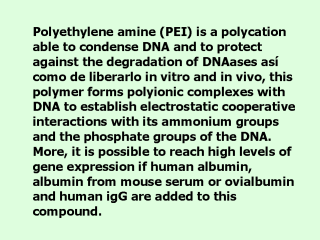| front |1 |2 |3 |4 |5 |6 |7 |8 |9 |10 |11 |12 |13 |14 |15 |16 |17 |18 |19 |20 |21 |22 |23 |review |
 |
The
polyionic complexes have a solubility problem, due to the neutralization of
charges. In order to resolve this problem this type of compound is joined to
a nonionic polymer soluble in water: polyethyleneglycol (PEG), resulting in
an increase in the solubility, a decrease in the toxicity and an increasein
the efficiency of transfection.
PEI favors high levels of expression of a transgene after administration by aerosol, with toxicity and cytokine response minimum and without acute inflammation. Via this type of system, antitumeral effects have been attained in 2 different cancer models using the suppresser gene p53. An aerosol system has been used in the murine melanoma B16-F10 for the administration of the PEI-p53 complex, achieving significant tumor reduction and a 50 % increace in survival. The mechanism of these p53 antitumoral effects is due in part to the supression of angiogenesis, due to the overregulation of the angiogenic factor thrombospondine 1 (TSP-1) in the lung tissue and under low regulation of the vascular endothelium factor (VEGF). |